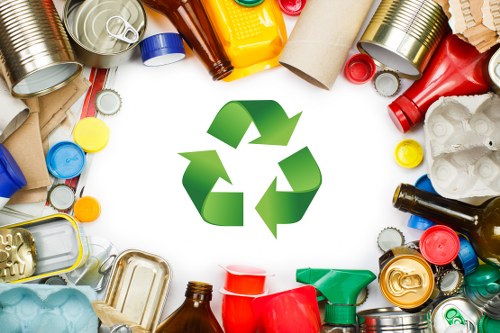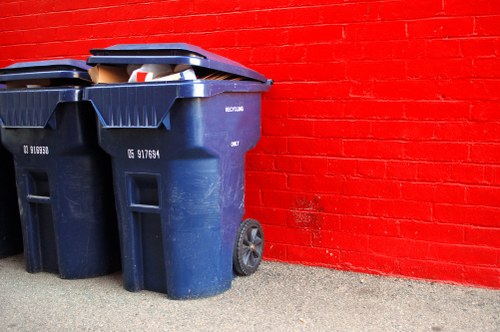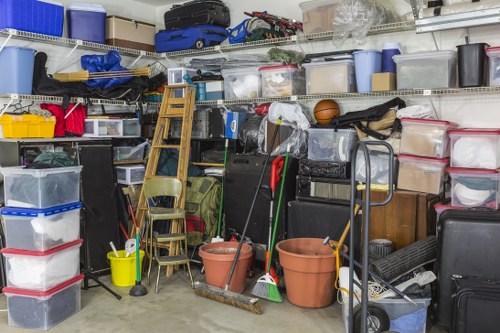Waste Clearance in Builders Waste
Introduction to Waste Clearance in Builders Waste

Waste clearance in builders waste is an essential service in the construction industry, ensuring that construction sites remain clean, safe, and environmentally friendly. In today’s fast-paced urban development, construction companies are generating a tremendous amount of debris that, if not managed properly, can cause severe environmental and safety hazards. This introductory section delves into the significance of builders waste management and highlights the practices that help mitigate negative impacts. Efficient waste clearance not only streamlines construction processes but also plays a pivotal role in urban sustainability and public health. As construction projects continue to expand, the need for comprehensive waste clearance services becomes increasingly vital.
Understanding the concept of waste clearance in builders waste involves analyzing the entire process of debris removal from construction sites. By adopting systematic and regulated waste clearance methods, companies can drastically reduce pollution and adhere to stringent environmental laws. Compliance with these regulations ensures that waste is not just removed, but responsibly recycled or disposed of, which helps maintain the delicate balance between urban development and nature conservation. Various factors influence the process, including the type of construction work, the volume of waste generated, and local legal requirements.
Furthermore, waste clearance in builders waste has evolved significantly over the past few years, with technology and innovation playing a major role in transforming traditional methods. Today, companies employ advanced machinery and specialized waste processing techniques that enhance operational efficiency and ensure precision. These modern solutions reduce turnaround time and offer an eco-friendly approach to construction debris management. The commitment to sustainable waste management is a testament to the industry's dedication to a cleaner future, making every construction project not just a building venture but also a step towards environmental preservation.
The Environmental and Legal Importance of Managing Builders Waste

It is crucial to understand that waste clearance in builders waste is not merely about cleaning up construction sites—it’s about fostering a responsible culture that values environmental sustainability and adherence to the law. The construction industry, while economically beneficial, often leaves behind remnants of debris that can contaminate the surrounding ecosystem if not managed properly. By focusing on responsible waste clearance, companies ensure that hazardous materials are safely handled and that recyclable resources are recovered, thereby reducing the strain on natural resources.
In many regions, strict environmental regulations have been put in place to govern the disposal and recycling of builders waste. Failing to comply with these legal norms can lead to hefty fines and even project shutdowns. Builders waste may include materials like concrete, wood, and metal, which, if not processed correctly, may harm soil and water quality. Underlining the legal ramifications, industry experts argue that effective waste clearance not only promotes a better public image but also secures long-term operational benefits by reducing risks associated with toxic spills and contamination.
Moreover, the legal frameworks established across various jurisdictions emphasize the importance of recycling and reusing construction materials whenever possible. This approach is instrumental in reducing landfill usage and minimizing the ecological footprint of construction projects. With the increasing demand for eco-friendly practices in the construction industry, waste clearance in builders waste has become a cornerstone of innovative waste management strategies. The commitment to sustainability is clearly reflected in every stage of the project— from the initial debris sorting to the final recycling process.
Effective Strategies for Waste Clearance in Construction Sites

Developing a robust strategy for waste clearance in builders waste starts with meticulous planning from the very beginning of a project. Construction companies are increasingly adopting multi-faceted approaches that involve early planning, on-site sorting, and the utilization of modern machinery. A well-planned strategy minimizes the risk of complications during construction, ensures compliance with state regulations, and promotes environmental accountability. Companies often carry out comprehensive waste audits to identify the types and amounts of debris generated, which then inform the selection of appropriate waste management techniques.
One effective tactic is the creation of dedicated areas on-site for temporary waste storage. These designated zones allow for an organized accumulation of debris, facilitating more efficient removal and segregation of different waste materials. The integration of advanced tracking systems aids in monitoring the types and quantities of waste, ensuring that hazardous materials are identified and processed according to strict safety standards. This method not only streamlines the waste clearance process but also assists in detailed reporting for regulatory compliance and environmental sustainability.
In addition to logistical improvements, technological innovations have significantly transformed waste clearance in builders waste. Portable waste compactors, automated sorting systems, and eco-friendly transport vehicles contribute to faster and safer clean-up processes. By leveraging these technologies, companies can promptly remove waste, thereby reducing potential risks associated with cluttered construction sites. Such measures underscore the importance of using state-of-the-art equipment and modern methodologies to maintain an organized and hazard-free work environment. Book your service now to experience the benefits of a streamlined and sustainable waste management system on your construction site.
Innovative Technologies Driving Builders Waste Management

Modern technology is revolutionizing the way we approach waste clearance in builders waste, transforming conventional practices and enhancing overall efficiency. With the rapid advancement in equipment and software, construction companies now have access to sophisticated tools that improve the management and processing of construction debris. For example, innovations like automated waste sorting machines not only boost speed but also ensure high accuracy in segregating recyclable and non-recyclable materials. These advancements are critical for improving the sustainability measures within the construction sector while adhering to increasingly stringent environmental policies.
One of the most groundbreaking technologies includes real-time waste monitoring systems. These systems provide continuous updates on the waste accumulation and help preempt potential issues before they escalate. Integrating these digital solutions into traditional waste management practices enhances transparency and ensures timely intervention, which is crucial for maintaining operational efficiency. The use of sensors and IoT devices can detect hazardous waste components and alert operators instantly, further emphasizing the importance of advanced technology in our waste clearance strategies.
Another significant benefit of these innovations is the boost in recycling rates for builders waste. With cutting-edge material recovery facilities and advanced processing algorithms, the transformation of debris into reusable resources has become more effective and economical. Companies can now identify and extract valuable components from waste, which can then be reintroduced into the manufacturing process. This not only reduces environmental impact but also contributes to a circular economy where materials are continuously reused. Contact us today to learn more about integrating smart waste clearance technology into your construction projects and contributing to a greener future.
Steps Towards a Greener Future with Efficient Waste Clearance

Achieving a greener and more sustainable construction environment requires ongoing innovation and dedicated efforts towards effective waste clearance in builders waste. The final phase of our discussion focuses on practical steps that can be implemented to reduce the environmental impact of construction activities. By establishing stringent waste management protocols from the onset, companies can ensure that most of the debris is recycled or disposed of safely, thereby minimizing the ecological footprint of construction projects. Emphasizing sustainability, these practices contribute significantly to resource conservation, cost savings, and improved community health.
The process of optimizing waste clearance involves several key stages: initial waste segregation, safe storage, timely collection, and final recycling or disposal. Each phase is crucial in ensuring that the waste management system operates smoothly and all potential hazards are addressed. Effective communication between project managers, site workers, and waste clearance teams is essential to ensuring that schedules are adhered to and that the process remains transparent and compliant with local regulations. The implementation of these best practices not only enhances operational efficiency but also educates all stakeholders about the long-term benefits of sustainable waste management.
Looking ahead, the construction industry must continue to invest in training, technology, and innovative practices to further advance waste clearance in builders waste. The integration of educational programs on waste management, combined with government incentives for eco-friendly practices, can drive significant improvements in the sector. Furthermore, promoting a culture of sustainability requires a collaborative approach that involves industry leaders, environmental experts, and policy-makers. Adopting these cutting-edge practices will not only improve the efficiency of construction projects but also foster a healthier, more sustainable environment for future generations. Book your service now and join the movement towards a sound, sustainable construction industry.
Understanding the Lifecycle of Builders Waste

To truly appreciate the essence of waste clearance in builders waste, it is important to understand the lifecycle of construction debris. The process begins at the planning stages of a construction project, where designers and engineers estimate the potential waste output. This forethought leads to better waste segregation practices at the source. As debris accumulates on-site, it is systematically sorted and separated into recyclable and non-recyclable categories using advanced sorting mechanisms. This lifecycle approach not only minimizes waste but also maximizes resource recovery, making it an essential component in sustainable construction management.
Following the initial sorting, specialized companies take over the waste removal process, ensuring that hazardous materials are handled with utmost care. Regular pickups and transportation to recycling facilities or designated disposal sites are part of the well-orchestrated lifecycle management. Several steps are involved, including documenting the volume and types of waste, treating potentially hazardous materials, and certifying that all procedures comply with local environmental regulations. The entire process is designed to minimize any negative impact on the surrounding community and the environment at large.
Adopting a lifecycle perspective transforms how construction companies view their waste. Instead of treating disposal as a mere afterthought, waste becomes a resource that, when managed intelligently, can be repurposed and reinvested back into the production cycle. This circular approach is gaining traction in the construction industry as more companies recognize the long-term economic and environmental benefits. Contact us today to explore how lifecycle management of builders waste can result in operational benefits and improved community health.
Environmental Benefits and Economic Advantages

The environmental benefits of an effectively executed system for waste clearance in builders waste are immense. By reducing the amount of waste that ends up in landfills, companies can help mitigate the greenhouse gas emissions associated with waste decomposition. Moreover, recycling and reusing construction materials contribute significantly to the conservation of raw materials. When construction waste is processed efficiently, it can be transformed into new products, lessening the need for virgin resources and reducing overall production costs. This not only results in environmental benefits but also yields economic advantages that can be reinvested into further sustainable practices.
Effective waste clearance has also proven to be a cost-saving measure in the long run. Although investing in advanced machinery and proper sorting techniques may initially seem costly, the economic returns are significant. Regular waste audits and improved recycling techniques can reduce disposal fees and ensure that valuable materials are recouped. This efficient system promotes a closer alignment between environmental responsibility and financial prudence—a dual benefit that is increasingly important as industries seek to balance profit margins with sustainable practices. In today's competitive market, demonstrating commitment to environmental stewardship can also enhance a company's public image and attract eco-conscious clients.
Beyond cost savings, this process builds public trust and contributes to regulatory compliance, which ultimately avoids the penalties and fines associated with improper waste disposal. Construction companies that implement these practices often enjoy long-term benefits that include higher project efficiency, reduced risk of accidents, and a notable reduction in environmental impact. Adopting these cutting-edge strategies is not merely a trend; it's a necessary evolution towards building a sustainable future.
Training, Compliance, and Continued Innovation

Investing in proper training and ongoing education for workers is an integral element of successful waste clearance in builders waste. Employees must be well-versed in safety protocols, waste segregation procedures, and emergency responses to address unforeseen circumstances on site. By prioritizing worker safety and integrity in waste management processes, companies not only adhere to strict safety regulations but also promote a culture of environmental responsibility. Specialized training sessions and certification programs are often organized in-house, ensuring that team members are updated with the latest techniques and regulatory changes in waste clearance. Emphasis on proper training means fewer accidents, improved morale, and an overall boost in operational efficacy.
Additionally, compliance with legal requirements is not optional but an absolute necessity for all construction projects dealing with builders waste. Governments and local authorities have established clear guidelines to deter improper disposal methods and reduce environmental degradation. By ensuring that every process within waste clearance strictly follows these guidelines, companies can avoid legal repercussions while contributing to a cleaner and safer environment. Equally important is the use of modern software to monitor compliance, track waste movement, and generate environmental performance reports. This transparency builds credibility and trust among regulatory bodies and the community.
As the construction industry evolves, it is vital to remain at the forefront of technological innovation and waste management practices. Continued investment in new technologies, such as AI-powered recycling systems and environmentally friendly disposal methods, further enhances the capabilities of waste clearance operations. These advancements not only streamline the process but also reduce the overall environmental impact. By continuously evolving, the industry can build a foundation for a greener future where waste is minimized and every material is utilized to its fullest potential. Book your service now to be part of this sustainable revolution in construction waste management.
The Role of Community and Future Perspectives

Looking to the future, effective waste clearance in builders waste will depend heavily on community involvement and government support. The role of local communities in recycling efforts, resource recovery, and even volunteer clean-up drives is becoming increasingly prominent. By fostering a shared sense of responsibility, neighborhoods can actively participate in the process of waste management, turning what was once a purely industrial task into a community-driven initiative. Such participation not only enhances the overall success of waste clearance strategies but also builds stronger community ties and improves public health.
Community engagement is further supported by public education campaigns and local workshops that demystify the processes involved in safe debris removal. As citizens become more aware of the environmental and economic benefits of proper builders waste management, there is greater pressure on companies to maintain high standards of waste clearance. Government incentives, such as tax breaks and subsidies for sustainable practices, reinforce these efforts. These initiatives contribute to a virtuous cycle where communities, businesses, and local authorities work synergistically towards a cleaner, greener future.
In addition to community involvement, future perspectives on waste clearance include a stronger emphasis on research and development. Academic institutions and industry leaders are collaborating to explore innovative recycling techniques and eco-friendly materials that can further drive down the environmental impact of construction waste. This forward-thinking approach places sustainability at the heart of future construction projects, ensuring that future generations inherit a healthier planet. Contact us today to find out how your construction project can benefit from the latest advancements in waste management and join us in paving the way toward a sustainable tomorrow.
Embracing a Culture of Sustainability

In conclusion, embracing waste clearance in builders waste as a fundamental principle of construction management is critical for achieving lasting environmental benefits and operational excellence. The strategies discussed herein—from lifecycle management and technological innovation to community engagement and regulatory compliance—form a robust framework that supports a sustainable future. By integrating advanced waste management practices into every phase of a construction project, companies can not only improve efficiency but also bolster their reputation as responsible stewards of the environment. Each step taken towards better debris management contributes to lowering hazardous exposures and enhancing urban aesthetics, reflecting a growing commitment to sustainability.
Moreover, the transformation of waste from a troublesome by-product to a resource with significant potential is redefining industry standards. Through recycling initiatives, safety protocols, and continuous investment in innovative technology, the construction industry is setting a new benchmark for waste clearance that benefits both businesses and communities alike. This cultural shift in attitude towards builders waste sets the stage for a broader change in environmental policy and urban planning, ensuring that growth can be achieved without compromising our planet’s health. Book your service now to join the forefront of this pioneering movement and help lead the change towards a greener future.
As we move forward, it is vital that all stakeholders in the construction industry work together to enhance the processes for waste clearance in builders waste. The synergy between technology, community effort, and strict environmental regulations will drive the next generation of construction practices. By remaining committed to innovative and sustainable waste management, the industry can continue to thrive while protecting ecological balance. This integrated approach not only safeguards public health but also paves the way for smarter resource utilization. Let’s collaborate to create cleaner, safer, and more sustainable construction sites everywhere. Contact us today to be part of this transformative journey and make a lasting positive impact on our environment.